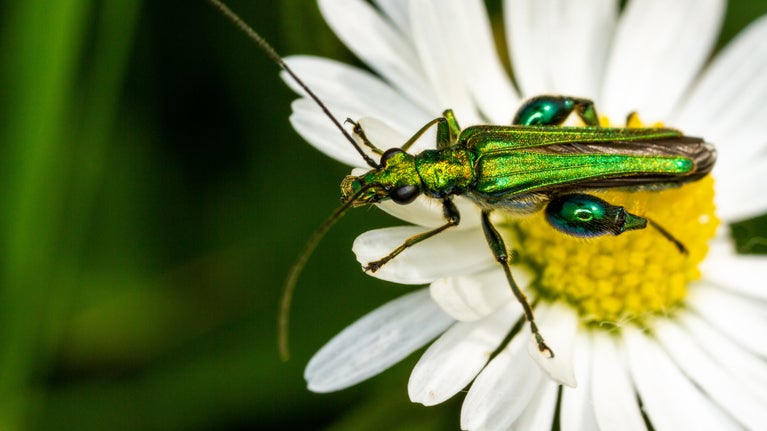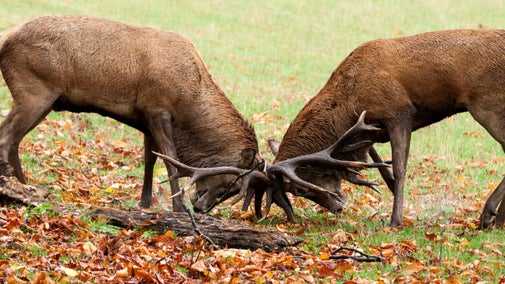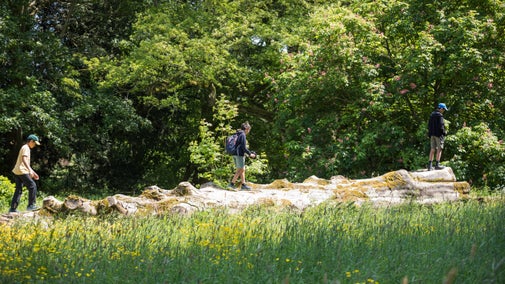
Get closer to wildlife
Discover tips for spotting mammals, birds and insects each season and learn about the range of wildlife at the places we look after.

Deer are naturally cautious animals that move in small groups and avoid humans. They are surprisingly hard to spot amongst trees and it's possible to pass very close to them without seeing them. Here are our tips for spotting deer and photographing them, as well as everything you need to know about the some of the deer species at the places we care for.
We recommend walking quietly and slowly on paths and well-used tracks that are away from roads. Dogs can scare off the deer so, for the best chance of spotting them, leave your four-legged friend at home. If you are bringing your dog, keep them on a short lead.
Be aware of the direction of the wind, as your scent will carry. Avoid wearing brightly coloured clothes – muted colours will help you to blend in with the surroundings.
The best time of day to see deer is at dawn and dusk when they are most active. Look between the trunks of the trees and into the darkest places for the give-away flick of a tail or the glint of a bright eye.
Deer have cloven hooves. In soft ground they leave tracks of two marks with pointed tips that have a gap in between them.
Muntjac deer typically leave small prints around 3cm long, while a red deer stag may leave prints as large as 9cm long. Roe and fallow deer tracks are about 5cm and 7cm long respectively.
Look out for hoof prints in soft mud and, in October, keep your eyes peeled for ‘fallow rings’. These are circles of hoof prints made by male deer during the rutting season. They are always found around tree stumps.
In summer, male deer grow an impressive set of antlers, which can be branched or unbranched, depending on the species. Antlers are made of bone and can grow at a rate of 2.5 cm a day. A soft velvet covering helps protect newly forming antlers as they grow, but this is shed once the antlers are fully grown.
Deer shed their antlers every year, and each year they grow back bigger until they reach their maximum size, around the age of eight. Generally speaking, the older the male, the larger and more impressive the set of antlers.
The majority of female deer don't grow antlers, but the females of some species do, such as reindeer.
Deer graze on grass and browse on trees and shrubs in woodlands. Much of their diet consists of grasses and flowers but they also eat the fresh young shoots of trees, shrubs and brambles. Some tree species are clearly favoured over others. For example, fallow deer prefer ash, hornbeam, sweet chestnut, hazel and sallow, while silver birch is one of their least favourite.
Like most herbivores, a deer's diet depends on the season, and during autumn they'll eat the fruits of the forest such as acorns, beech nuts, and sweet chestnuts. During winter, when food is harder to find, they’ll take the juicy buds from trees. When really pushed, such as in snow or severe winter weather, they’ll strip the bark from trees.

Fallow deer live both in the wild and as park deer at National Trust places.
They come in four colours: tan (common), menil (paler than tan), melanistic (black) and white. They were originally brought to England from the Mediterranean area during the Roman period but they're now considered to be naturalised in Britain.
Fallow deer bucks (males) have distinctive palmate antlers with a broad flat centre. The anters of prickets (male yearlings between 1–2 years old) are simple spikes.
Muntjac deer live in the wild at National Trust places.
They're small and stocky and are sometimes mistaken for wild boar. Muntjac deer are native to Asia and it's thought that they escaped into the countryside from Woburn. They're now widespread across England and Wales.
Red deer live both in the wild and as park deer at National Trust places.
Red deer are the largest land mammal in the UK. These deer are easy to recognise from their size and the rusty red-brown colour of their hair.
Stags (males) weigh in at up to 240kg and stand 1.3m high at the shoulder. Mature males in peak breeding condition are around eight years old and can have a crown of antlers with up to 16 points, known as a ‘monarch’. Hinds (females) are smaller and don’t have antlers.
The sexes only mix during the rut and the winter period. Over the summer stags live in their own groups. Hinds will be single before calving, then come together in small family groups or bigger single sex groups after calving.
The breeding season for deer is known as the rutting season or simply 'the rut'. During this time, the males compete for the choice of females to mate with. The male deer won't eat during the rut as they try to protect their herd.
Rutting season for fallow deer begins once the weather turns cold, usually in October. At this time of year, you can hear the bucks making loud, deep, groaning calls to attract a doe (female). The sound of the groan is directly related to the size of the male, although it’s not possible for humans to hear the difference.
For other bucks, however, this difference in sound is very important. It can help them to know how strong another buck is likely to be and whether it’s worth the risk of challenging them. If they are closely matched in size, bucks may test their strength by pushing and shoving each other with their antlers.
The red deer rut starts in mid-September and runs until mid-October.
Their bellows can be heard resonating across the moors, and if the loudest roar doesn’t decide the dominant male, stags will size each other up with ‘parallel walking’. Equally matched males will occasionally lock antlers, aiming to use their massive strength to physically push the other male out of their territory. The winner of these competitions is rewarded with a harem of females with whom they breed.
At this time, older and younger males often live on the periphery of the herd, hoping to mate with another stag’s females while he is otherwise occupied.

The rut is an impressive sight to see but during this time the deer are under a lot of pressure.
Be aware that male deer can be aggressive towards humans during the rut and may charge if you get too close. We ask you to be respectful of them and keep your distance.
Here are the key safety points for photographing the deer.

Discover tips for spotting mammals, birds and insects each season and learn about the range of wildlife at the places we look after.
Every autumn, drama unfolds as male deer lock antlers in competition for females. Find out where you can visit during deer rutting season to see one of nature's annual spectacles.

If you're keen to capture the beauty of nature at the places in our care, read our tips on taking better photos, from how best to frame your subject to perfectly capturing movement.

Learn how to spot red squirrels, the best times to see them and how to tell them apart from grey squirrels.

Looking to catch a glimpse of a red squirrel or a rare butterfly? Follow our top tips for getting up close (but not too close) with wildlife.

Although otter numbers are on the rise, the shy and elusive marine mammals are still notoriously difficult to find. To boost your chances, here are our top tips on how to spot them in the wild.

Discover how to spot butterflies without scaring them away, and find out which types of plants will attract them to your garden or green space.

Get closer to nature by reading our guides on how to spot wildlife, facts about ancient trees and tips on identifying birdsong, plus many more activities.

Plan a visit to one of the special countryside places in our care and discover the benefits of being in the great outdoors. Pack your walking boots and get ready to explore woodlands, valleys and rivers.
